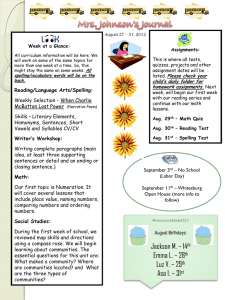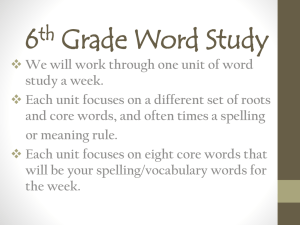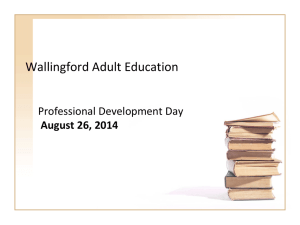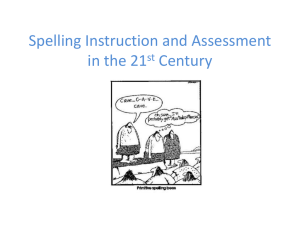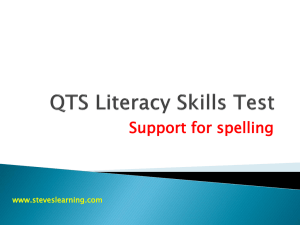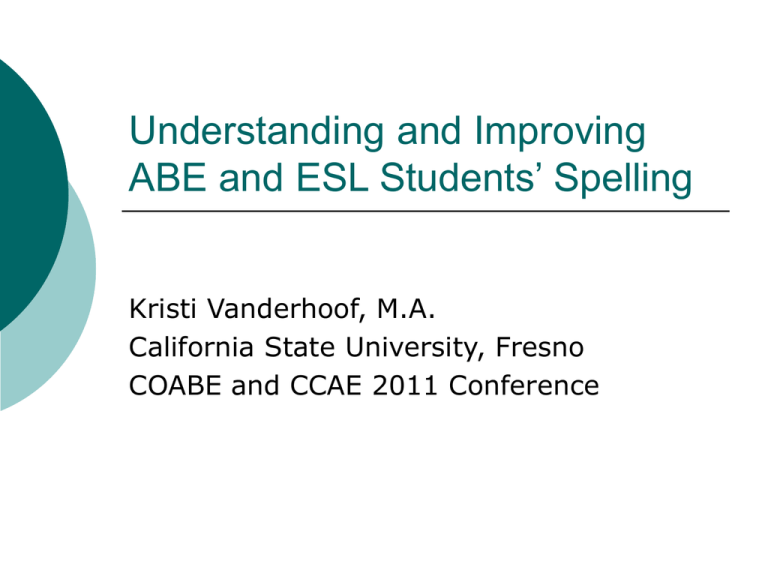
Understanding and Improving
ABE and ESL Students’ Spelling
Kristi Vanderhoof, M.A.
California State University, Fresno
COABE and CCAE 2011 Conference
Spelling Processes and Skills
Phonological Processing:
decoding the sounds in the word
and recoding it with graphemes
Orthographic Processing: using a
visual memory of the word
Some people only use orthographic
processing; others use both
Stages of English Spelling
Development
G
PZRBL
PEZURABOL
PAESHIRBOLE
PLESHURABOLE
PLESURABLE
PLEASURABLE
Pre-phonetic
Phonetic/semi-phonetic
Phonetic
Transitional
Patterns Within Words
Syllable Juncture
Derivational Morphology
Comparing Spelling Development
Native English-speaking adults and
children, and native-Spanish speaking
children progress through the same
stages
Adults tend to prefer orthographic
strategies (relying on visual memory of
words)
ESL learners tend to rely more on
knowledge from their L1 until they gain
more L2 knowledge
Spelling Errors for Non-Native English
Speakers
Phonological errors: when students hear a
phoneme that they do not have in their
long term memory and replace it with a
similar phoneme from their L1
Example: writing SHEEP or CHIP for ship
Related to perception/production of English
sounds
Orthographic Errors: due to a lack of
knowledge of how sounds are represented
in English
Example: Spanish speakers writing JIRO for
hero
Example: Arabic speakers writing WSHWAL for
usual
Adult ESL Students
Possible advantages:
More literacy experience with their L1
Positive transfer if writing system is
similar to that of English
Possible disadvantages:
More difficulty with hearing and
producing English sounds
Research Questions
Do adult ESL students and Native
English-speaking adults follow the
same path of development when
learning English spelling?
Do adult ESL students have
difficulties with decoding sounds
even after they have passed the
phonetic spelling stage?
Participants
97 students at an adult school in
California
44 English as a Second Language (ESL)
students and 53 adult basic education
(ABE) students
English as a Second Language (ESL)
students:
Reading level was determined by most recent
score on the CASAS test, a work readiness
literacy test
ABE Students:
Reading Level was determined by most recent
score on TABE
Level
ESL
ESL
ABE
H-Int L-Adv Beg.
N=17 N=27 N=11
ABE
L-Int
N=23
ABE
H-Int
N=19
Adult
High
School Int.
ESL
Level
Low
Adv.
ESL
Beg.
ABE
Low
Int.
ABE
High
Int.
ABE
CASAS 211220
221235
Less
than
211
211220
221235
TABE
6.08.9
2.03.9
4.05.9
6.08.9
4.05.9
Procedures
Background Survey
Language
Education
Literacy
Diagnostic Spelling Test
Analysis of the types of words
misspelled
Analysis of types of errors produced
Average Score on the Real-Word
Portion of the Spelling Test
Level
Avg.
Score
ESL
H-Int
N=17
13.29
ESL
L-Adv
N=27
14.59
ABE
Beg.
N=11
17.55
ABE
L-Int
N=23
19.26
ABE
H-Int
N=19
23.32
Avg. % 51.1% 56.1% 67.5% 74.1% 89.7%
% Diff.
5.0%
6.6%
15.6%
Words Misspelled by 50% or More Students
Level
ESL
H-Int
ESL
L-Adv
Words
closet
WWP
cattle
cattle
float
float
ABE Beg. ABE
L-Int
ABE
H-Int
chase
Sight
caught
caught
caught
squirrel
squirrel
squirrel
squirrel
cellar
cellar
cellar
cellar
beauty
SJ
DM
preparing
popping
popping
satisfied
satisfied
satisfied
satisfied
puncture
puncture
puncture
puncture
fortunate
fortunate
fortunate
pleasure
fortunate
squirrel
Percentage of Students at Each Level Who Spelled
Pseudo-Words Plausibly
100.0%
80.0%
ESL Low
60.0%
ESL High
ABE Low
40.0%
ABE Inter
20.0%
ABE High
0.0%
shab
deet
strammed
shabbity
Examples of Spellings of
Words at Five Stages
SemiPhonetic Trans
Phonetic
WWP
SJ
sp
sep
shep
sheap
sheep
chip
sip
ship
N/A
drive
jrv dr j
driv
drav
jraiv
drave
drive
N/A
cattle
ctl cat
catl cato cuttle
cattow
caro
cawto
catle
catel
cattle
cattel
caddle
ship
Percentage of Students Who Used a Particular
Spelling Strategy At Least Twice
120.0%
100.0%
N
80.0%
S
P
60.0%
T
40.0%
W
20.0%
J
0.0%
ESL Low
ESL High
ABE Low
ABE Inter
N=Non-Phonetic S=Semi-Phonetic P= Phonetic
W = Word Patterns
J= Syllable Juncture
ABE High
T=Transitional
Pseudo-words:
Percentage of Students Who Used a Particular
Spelling Strategy At Least Once
120.0%
100.0%
80.0%
P
60.0%
T
W
40.0%
20.0%
0.0%
ESL Low
P= Phonetic
ESL High
ABE Low
ABE Inter
T=Transitional W = Word Patterns
ABE High
Discussion of Qualitative Results
ESL students employed a transitional
spelling strategy most often
lack of increase in overall spelling performance
is linked to lingering phonological difficulties
ABE students at higher levels use more
advanced strategies than those at lower
levels
ABE students’ spelling development is more
traditional
Cognates:
Other possible L1 interference
Some of the native Spanish speakers
spelled satisfied in the following
way:
SATISFACED
SATISFACTION
SATISFICE
None of the ABE students spelled the
word in this way.
Satisfacer (Spanish) = satisfied
(English)
Conclusions
CASAS reading scores may not be
accurate indicators of ESL students’
English spelling ability.
ESL students’ spelling may develop
slightly slower than that of ABE students.
A deficiency in phonological awareness
may hinder ESL spelling development.
Low ABE students need more help with
sight words
Low and Intermediate ABE students
would benefit from syllable juncture
instruction
Suggestions for Further Research
Conduct a longitudinal study that
compares ABE and ESL students’
spelling
Test ESL students’ perceptions of
sounds, versus their ability to write
those sounds
First Recommendation
Increase students’ phonemic awareness,
especially for beginning ABE, and all ESL,
students
Beginning ESL readers have more difficulty
spelling sounds that are not present in their
L1
Poor spellers are more likely to make
phonologically implausible errors
Students with better phonemic awareness
can memorize more sight words
Phonemic awareness is correlated with word
recognition and reading for native speakers
and ESL students
Increase Students’ Phonemic
Awareness
Songs and poems that rhyme
Phonics Through Poetry
Jack Prelutsky, Shel Silverstein
Tongue twisters and alliterations with
blends
Change names to call roll
Same or Different?
Individualized activities in the computer
lab
Phonetic bingo
Coming Out of the Shoe Shop
Got new shoes
so I can hop.
I can stomp
and I can clop.
I can even
flip and flop.
The problem is—
I cannot stop!
--Eileen Spinelli
Increase Students’ Phonemic
Awareness
For ESL students:
Pronunciation:
Individualized activities in the computer lab
Minimal pair Tic-Tac-Toe
Songs and poems
English Front Vowels
Short E
Yes
Help
Every
Wednesday
Long A
Make
Sale
Same
Front
High /i/ beat “long E”
/I/ bit “short I”
Mid
/e/ bait “long A”
/ε/ bet “short E”
Low
/æ/ bat “short A”
Second Recommendation
Instruct students in common English
spelling patterns and syllable
juncture changes
Beginning and low intermediate ABE
students demonstrate a lack of
knowledge in these areas
High intermediate ABE students can
spell patterns-based words more
successfully
Spelling Patterns
Reading:
Notice common word patterns in a text
Hickory Dickory Dock (notice how /k/
sounds are represented)
Read rhyming poems
Grouping words from the same family
Give students a list of words and ask
them to categorize the ones with similar
spellings
Have students circle words in a text
Hickory Dickory Dock
Hickory Dickory Dock!
The mouse ran up the clock.
The clock struck one.
The mouse ran down!
Hickory Dickory Dock!
Hickory Dickory Dock
Hickory Dickory Dock!
The mouse ran up the clock.
The clock struck one.
The mouse ran down!
Hickory Dickory Dock!
Memorize these words!
Tylla
Mackarn
Norsebe
Mylla
Starn
Trebe
Memorize These Words!
Tylla
Mylla
Norsebe
Trebe
Mackarn
Starn
Syllable Juncture Changes
Integrate with grammar lessons:
Changing y to ie (story stories)
Doubling consonants (swim
swimming)
Deleting silent e (bake baking)
Activities
Chain stories
Watch a video and retell the story
Tic Tac Toe and Bingo
Relay
Writing sentences and categorizing the
verbs according to spelling rules
Consonant Doubling
If the last 3 letters in the word are
CVC (Consonant-Vowel-Consonant),
double the last consonant when you
add –ED or –ING.
Pop + -ED = Popped
Trap + -ING = Trapping
Sort these verbs
Swim
Watch
Get
Stop
Call
Run
Hop
Skip
Teach
Learn
Encourage Students to Write!
Encourage students to spell a word,
even if they are unsure:
Replace missing letters with a dash:
On We—sday, we have class.
Put a question mark in parentheses if
you are not sure:
On Wendsday(?), we have class.
Source: Teaching Spelling and Phonics in a
Whole Language Classroom
Avoid Spelling Words for Students
at First
Instead:
Tell the student which letters are correct
Tell the student if a letter is missing
Prompt the student with a word he/she knows
that has a similar pattern
Refer the student to a text/chart that contains
that word
Pronounce the word the way the student has
written it
Source: Teaching Spelling and Phonics in a
Whole Language Classroom
General Suggestions
Keep spelling instruction within the
context of meaning as much as possible
Encourage students to notice spelling
patterns themselves
Use multi-sensory methods
Group words so that they are easier to
remember
Encourage students to write!
Use spelling logs
Acknowledgments
California State University, Fresno,
and my mentors, Drs. Barbara Birch
and Ellen Lipp
The adult school that allowed me to
do my research there
The American English Institute in
Fresno, which provided me with the
projector!
References
Bear, D.R., Truex, P., & Barone, D. (1989). In search of meaningful
diagnosis: Spelling-by-stage assessment of literacy proficiency. Adult
Literacy and Basic Education, 3, 165-185.
Beers, J.W. (1980). Developmental strategies of spelling competence in
primary school children. Developmental and cognitive aspects of learning
to spell: A reflection of word knowledge. Eds. E. H. Henderson & J.W.
Beers. Newark, Delaware: International Reading Association, 36-45.
Birch, B. M. (2007). English L2 reading: Getting to the bottom. 2nd ed.
Mahwah, NJ: L. Erlbaum Associates.
Boiarsky, C. (1969). Consistency of spelling and pronunciation deviations of
Appalachian students. Modern Language Journal. 53(5), 347-350.
Burt, J.S., and Blackwell, P. (2008). Sound-spelling consistence in adults’
orthographic learning. Journal of Research in Reading, 31 (1), 77-96.
Cramer, R.L. (1998). The spelling connection: Integrating reading, writing,
and spelling instruction. New York: Guilford Press.
Ehri, L. (1989). The development of spelling knowledge and its role in
reading acquisition and reading disability. Journal of Learning Disabilities,
22(6).
References (contd.)
Diffily, D., and Sassman, C. (2006). Engaging Activities to Teach Phonics
and Phonological Awareness. Greensboro, NC: Carson-Dellosa Publishing,
Inc. Ehri, L. (1986). Sources of difficulty in learning to spell and read. In M.
L. K. Wolraich & D. Routh (Eds.), Advances in developmental and
behavioral pediatrics (pp. 121-195). Greenwich, CT: JAI.
Fashola, O. S., Drum, P. A., Mayer, R. E., & Kang, J. S. (1996). A cognitive
theory oforthographic transitioning: Predictable errors in how Spanishspeaking children spell English words. American Educational Research
Journal, 33, 825–843.
Figueredo, L. (2006). Using the known to chart the unknown: A review of
first-language influence on the development of English-as-a-secondlanguage spelling skill. Reading and Writing. 19: 873-905.
Greenberg, D., Ehri, L.C., & Perin, D. (2002). Do adult literacy students
make the same word-reading and spelling errors as children matched for
word-reading age? Scientific Studies of Reading. 6(3), 221–243.
Hajdusiewicz, B.B. (1999). Phonics Through Poetry. Glenview, IL: Good
Year Books. Henderson, E. H. (1990) Teaching Spelling. 2nd ed. Boston:
Houghton Mifflin.
References (contd.)
Harrison, G.L., & Krol, L. (2007). Relationship between L1 and L2 wordlevel reading and phonological processing in adults learning English as a
second language. Journal of Research in Reading, 30 (4), 379-393.
Henderson, E.H. (1990). Teaching Spelling. 2nd Ed. Boston: Houghton
Mifflin.
Masterson, J., Laxon, V., Lovejoy, S., & Morris, V. (2007). Phonological skill,
lexical decision and letter report performance in good and poor adult
spellers. Journal of Research in Reading, 30 (4), 429-442.
Mazur, C. (2005). The effect of a reading program with focused fluency
instruction on reading comprehension and fluency of adult ESL learners.
Retrieved from Hamline University Department of Education PDF Database
(http://www.hamline.edu/education/pdf/)
Moats, Louisa Cook. Spelling: Development, Disability, and Instruction.
Baltimore: York, 1995.
National Reporting System. (2005). National Reporting System
Implemenation Guidelines. Retrieved from
http://www.nrsweb.org/foundations/
References (contd.)
Odlin, T. (2003). Cross-linguistic influence. In Catherine K. Doughty and
Michael H. Long (Eds.), The handbook of second language acquisition (pp.
436-486). Malden, MA: Blackwell.
Powell, D., and Hornsby, D. (1993). Learning Phonics and Spelling in a
Whole Language Classroom. New York: Scholastic Professional Books.
Seeff-Gabriel, B. (2003). Phonological processing a platform for assisting
second-language learners with English spelling. Child Language Teaching
and Therap, 19(3), 291-310.
Stever, E. F. (1980). Dialect and spelling. Developmental and cognitive
aspects of learning to spell: A reflection of word knowledge. Eds. E. H.
Henderson & J.W. Beers. Newark, Delaware: International Reading
Association, 46-51.
Wang, M., & Geva, E. (2003). Spelling acquisition of novel English
phonemes in Chinese children. Reading and Writing, 16, 4, 325-348.
Wang, X., & Munro, M. J. (2004). Computer-based training for learning
English vowel contrasts. System, 32(4), 539-552.
Woodward, S.W. Fun With Grammar. Pearson Longman. Retrieved from
http://www.pearsonlongman.com/ae/
download/funwithgrammar/home.html
Zutell, A., & Allen, V. (1988). The English spelling strategies of Spanishspeaking bilingual children. TESOL Quarterly, 22(2), 333-340.


